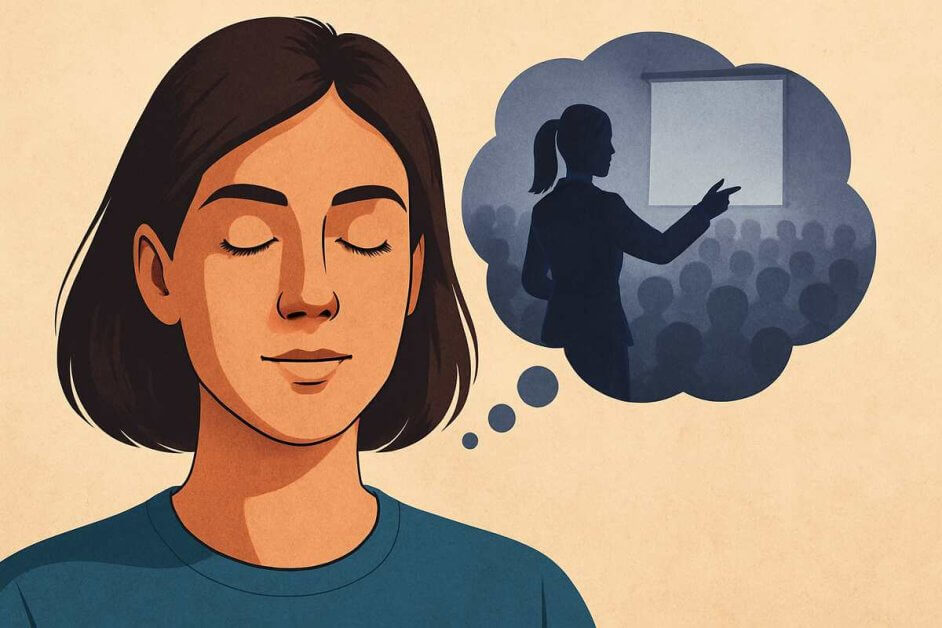
How to Visualize: The Science Behind Achieving Your Goals
Discover how science-backed visualization rewires your brain, boosts resilience, and helps you achieve goals in sports, work, and life.

Michael Phelps didn’t just swim laps to prepare for Olympic gold — he mentally rehearsed every stroke, every turn, and even the feeling of his goggles filling with water. By the time he stood on the starting block, his brain had already “lived” the race dozens of times. This isn’t superstition or wishful thinking — it’s neuroscience.
Visualization, or mental imagery, works because it leverages the brain’s ability to rewire itself, a phenomenon called neuroplasticity. When used correctly, visualization can improve confidence, sharpen focus, and accelerate learning across everything from sports and public speaking to test-taking and career goals.
In this article, we’ll explore the science behind visualization — why it works, the brain mechanisms involved, and how to practice it effectively.
When most people hear the word visualization, they usually picture daydreaming about a better future, such as a bigger house, a fitter body, or a dream job. That’s not what we’re talking about here. Effective visualization isn’t just wishful thinking; it’s a structured mental rehearsal that literally alters the wiring in your brain, almost as if you were living it.
Scientists call this mental imagery or mental rehearsal. Brain scans show that imagining yourself practicing a free throw, giving a presentation, or running a race lights up many of the same brain regions as actually doing those things. This is why top athletes, race-car drivers, and even surgeons use visualization to sharpen their performance.
What visualization isn’t is magic. It doesn’t replace hard work, and it’s not the same as “manifesting” success by thinking about it. In fact, only visualizing the perfect outcome can backfire, making you feel like you’ve already crossed the finish line before taking the first step.
Real visualization is about training your brain to expect effort, obstacles, and growth. When you rehearse both the steps and the stumbles — and see yourself working through them — you build stronger neural pathways for resilience and action. Think of it as giving your brain a test drive before the real performance.

Your brain is a living network under constant renovation, continually forming new neural paths and breaking old ones with the goal of efficiency and energy optimization. This ability to rewire itself is called neuroplasticity, and it’s the foundation of how visualization works.
Most people think of learning as simply adding new connections. That’s partly true: every time you rehearse a skill, your brain strengthens the circuits that control it. But neuroplasticity has a second, equally important side: pruning away or quieting down the noisy, inefficient connections.
Think of it like learning to play guitar. At first, your fingers stumble and you accidentally press the wrong strings — dozens of neural signals firing chaotically. Over time, practice doesn’t just strengthen the right pathways, it also suppresses the wrong ones.
The end result isn’t more connections, it’s better organized connections. Visualization taps into this same principle: it helps the brain rehearse not only what to do, but also what not to do.
Neuroscientists describe this in terms of long-term potentiation (LTP), which strengthens the right circuits, and long-term depression (LTD), which weakens the unhelpful ones. Visualization supports both — laying down stronger “yes, do this” patterns while quieting the mental noise that gets in the way.
That’s why visualization is so powerful: it doesn’t just add new wiring, it sculpts your brain into a more efficient, goal-focused network.

Close your eyes and picture yourself shooting a basketball or giving a speech. To your brain, that rehearsal isn’t just imagination — it closely resembles the real thing. In fact, studies show that mental imagery activates many of the same brain regions as actual practice. For example, an fMRI study found that when people learned a finger-tapping sequence, simply imagining the movement engaged much of the same motor and visual circuitry as physically performing it.
The effect extends beyond small tasks. A recent mobile EEG experiment revealed that even when participants only imagined walking, their motor networks displayed similar activity patterns to when they walked in reality. This overlap, known as neural equivalence, suggests that the brain treats vivid imagery as a kind of “practice run.”
Think of it like a flight simulator. Pilots can prepare for turbulence or emergency landings without leaving the ground because the simulator activates many of the same mental skills as real flying. Visualization provides the same advantage for your brain — letting you rehearse the performance before it happens.
Of course, imagery isn’t identical to action. As researchers reviewing motor imagery theory point out, the brain also recruits inhibitory circuits to prevent actual movement while still running the “program” internally.

But the takeaway is clear: by engaging much of the same neural wiring as real practice, visualization primes your mind and body so that when the moment arrives, it feels like you’ve already been there.
Visualization isn’t only about getting better at physical skills — it also reshapes how we think and feel. Guided imagery has been shown to improve life satisfaction, mood, and self-confidence, especially in people struggling with mild depressive symptoms.
In one study, participants who practiced self-guided positive imagery not only reported feeling more effective in daily life, but also performed better on tests of emotion recognition and non-verbal reasoning. In other words, visualization didn’t just change how they felt — it changed how they processed the world around them.
Brain imaging offers clues as to why. EEG research shows that visualization training alters activity in regions like the insular cortex, which regulates emotions and empathy, and the prefrontal cortex, which handles planning and self-reflection. This helps explain why people who visualize regularly often feel calmer, more focused, and better able to read social situations.
A helpful way to think about it: visualization acts like emotional weightlifting. Just as lifting weights strengthens your muscles, rehearsing positive images strengthens the circuits that regulate confidence, empathy, and resilience. Over time, this mental “training set” makes it easier to handle stress, connect with others, and think more clearly under pressure.
One of the most underrated benefits of visualization is how it improves decision-making. When you mentally rehearse possible futures, you’re not just fantasizing — you’re running simulations that help the brain prepare for what’s ahead.
A 2018 review on decision-making and visualization found that imagining different scenarios engages the same cognitive systems we use for reasoning, evaluating trade-offs, and anticipating outcomes. In other words, visualization isn’t just about seeing success — it’s about stress-testing your choices before you make them.
This is why the most effective visualizers don’t limit themselves to picturing the perfect outcome. Athletes, for instance, rehearse what happens if their opponent surprises them. Public speakers imagine what they’ll do if the projector fails or nerves kick in. By practicing both the smooth path and the bumps along the way, visualization builds “if-then” maps in the brain — if this happens, then I’ll respond like that.
Think of it like planning a road trip. You don’t just picture yourself arriving at the beach; you also check for road closures, plan detours, and prepare for traffic. Visualization gives your brain the same flexibility, so when obstacles appear, you’re not paralyzed — you’re prepared.
Your brain doesn’t need long, cinematic scenes to learn — it needs short, clear “mental reps.” Neuroscientist Andrew Huberman recommends keeping each visualization to 15–20 seconds and repeating it 50–75 times per session. Think of it like sets in the gym: one rep doesn’t build strength, but enough consistent, high-quality reps make the change stick.
Seeing yourself with the medal or promotion feels good, but it doesn’t train your brain for the work required. Visualization is most effective when you imagine the steps: the practice sessions, the effort, the execution. This wires your brain for persistence, not just wishful thinking.
The most powerful visualizations aren’t picture-perfect. They include the nerves, the fatigue, and the setbacks — followed by you pushing through them. By rehearsing how you’ll handle challenges, you create mental “if-then” maps that keep you calm and adaptable in real life.
The more realistic your imagery, the stronger the impact. Add sound, touch, and emotion: feel the sweat, hear the applause, or notice the silence of the room. Your brain responds more deeply when the scene feels lived-in.
Mental practice works best when combined with physical practice. Think of visualization as doubling your training volume without doubling the wear-and-tear on your body. The brain rehearses, the body executes — and together they reinforce the skill.
Neuroplasticity doesn’t happen while you’re visualizing — it consolidates during rest and sleep. To make your mental training stick, make sure you’re getting consistent, high-quality sleep. That’s when your brain “locks in” the new wiring.

Visualization has long been a secret weapon in athletics. Michael Phelps famously visualized every stroke of his Olympic races — including disasters, like his goggles filling with water — so when it happened in competition, his brain already knew how to respond.
Skiers rehearse every twist of a downhill course, fighters walk through their game plans, and gymnasts picture entire routines before they step on the mat. By the time the moment comes, their nervous system has “been there” already.

Few things spike anxiety like giving a presentation or leading a meeting. Visualization helps here too. Mentally walking through the speech — hearing your own voice, seeing the audience, feeling the nerves and then calming yourself — reduces anxiety and builds confidence. Many professionals also use visualization to rehearse negotiations, difficult conversations, or even job interviews.
Visualization isn’t just for peak performers. It’s used in rehabilitation for patients recovering from strokes, surgeries, or brain injuries. By imagining movements they can’t yet perform, patients keep neural circuits active, often speeding recovery. Older adults can also use visualization to reinforce skills when physical training alone isn’t possible.
The same principles apply to daily life. Students can rehearse studying and recalling answers before an exam. Runners can visualize pacing and endurance before a long run. Even small habits — like choosing healthier meals or practicing patience in stressful situations — can be strengthened through mental rehearsal.
It’s tempting to picture the finish line, the applause, or the promotion. But only focusing on the end result can actually backfire. The brain gets a premature reward, making you feel like you’ve already achieved the goal — which can reduce motivation to do the work.
Some people try to build long, movie-like scenes with endless detail. That usually leads to mental fatigue and less effective practice. Science shows that short, clear, repeatable images work best — think of them as mental “reps,” not feature films.
Visualization is most powerful when it includes obstacles — the nerves, the stumbles, the fatigue — followed by you overcoming them. Skipping these parts robs you of resilience training.
Mental rehearsal primes the brain, but it doesn’t replace real practice. Athletes don’t just imagine training; they combine visualization with hours of physical reps. The same is true for exams, speeches, or any skill you want to master.
Neuroplasticity doesn’t happen in the moment — it consolidates during rest. If you’re visualizing regularly but skimping on sleep, you’re missing the payoff.
We’ve covered the science — now let’s connect the dots and show how to bring visualization into your daily routine.
Treat visualization as an experiment. For the next seven days, spend just 5–10 minutes a day running through these mental “reps.” Notice how it shifts your focus, calms your nerves, or boosts your confidence. The science shows your brain is rewiring — but you’ll feel the difference for yourself when it shows up in real life.
Visualization, or mental imagery, works because it leverages the brain’s ability to rewire itself, a phenomenon called neuroplasticity. When used correctly, visualization can improve confidence, sharpen focus, and accelerate learning across everything from sports and public speaking to test-taking and career goals.
Your brain doesn’t need long, cinematic scenes to learn — it needs short, clear “mental reps.” Neuroscientist Andrew Huberman recommends keeping each visualization to 15–20 seconds and repeating it 50–75 times per session. Think of it like sets in the gym: one rep doesn’t build strength, but enough consistent, high-quality reps make the change stick.
The more realistic your imagery, the stronger the impact. Add sound, touch, and emotion: feel the sweat, hear the applause, or notice the silence of the room. Your brain responds more deeply when the scene feels lived-in.

Discover how science-backed visualization rewires your brain, boosts resilience, and helps you achieve goals in sports, work, and life.

Motivation isn’t magic — it’s brain chemistry. Learn how dopamine and neural pathways fuel drive, focus, and lasting productivity.

RSD is an intense emotional sensitivity linked to ADHD. Understand its symptoms and learn ways to manage emotional triggers effectively.

Want to better manage your emotions? These three powerful books offer insights and strategies for building calm, resilience, and self-mastery.

The benefits of grounding have been scientifically studied and include reductions in inflammation, diabetes, and stress.

Discover the secret on how to get rid of a cold sore fast in 24 hours with our proven treatment — clear, smooth lips start today!
You’ll Learn:
Effective Immediately: 5 Powerful Changes Now, To Improve Your Life Tomorrow.
Click the purple button and we’ll email you your free copy.